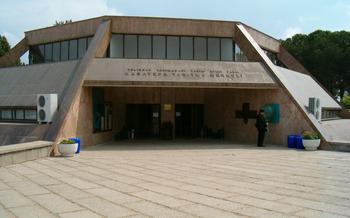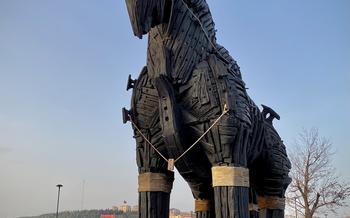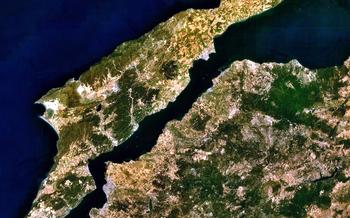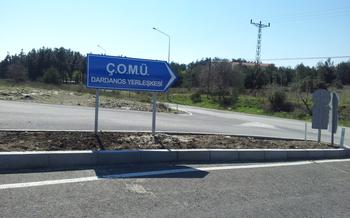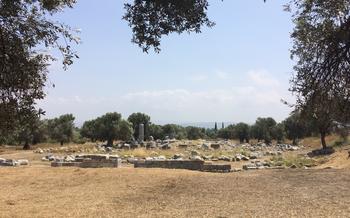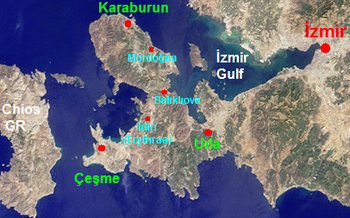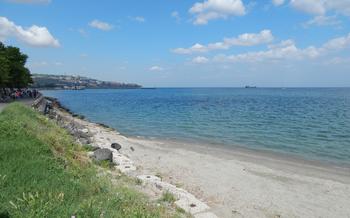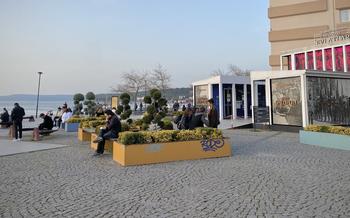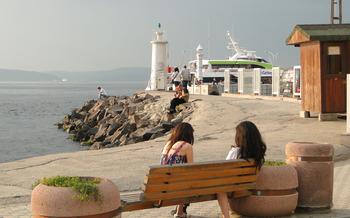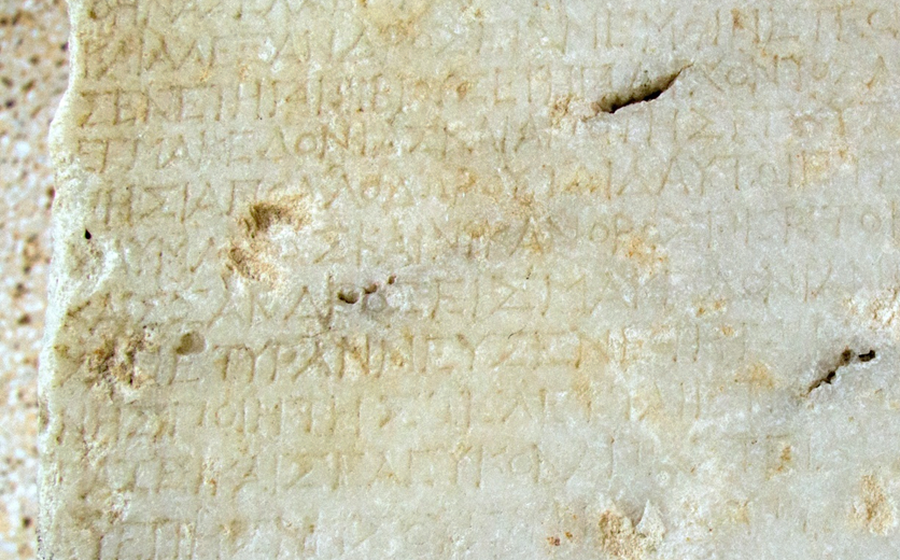
Ancient City of Parion
- The Antiquity of Parion
- The Enchanting Ruins
- The Odeon of Parion: A Stage for Ancient Melodies
- The Legendary Parion Mint
- The Alluring Landscapes
- The Archaeological Museum
- The Ancient Aqueduct: A Marvel of Engineering
- The Legendary Siege of Parion
- The Enduring Legacy of Parion
- Parion's Culinary Delights
- The Warm Hospitality of Parion
- Accommodation Options
- Getting to Parion
- Insider Tip: Unveiling the Hidden Treasures of Parion
The Antiquity of Parion
Parion, a city with an intriguing past, boasts a rich history dating back to ancient times. Founded in the 8th century BC by Greek colonists from Miletus, the city played a significant role in the region, serving as a vital port and trading hub. Its strategic location at the southern tip of the Gallipoli Peninsula made it a crucial gateway between the Aegean Sea and the Sea of Marmara.
Throughout its existence, Parion witnessed the rise and fall of various civilizations, each leaving their mark on the city's character. From the Greeks to the Romans, and later the Byzantines and Ottomans, Parion's diverse cultural heritage is reflected in its archaeological remains, offering a glimpse into the city's multifaceted past.
Extensive archaeological excavations conducted in Parion have unearthed a wealth of artifacts, shedding light on the city's ancient past. These discoveries include remnants of fortifications, temples, theaters, and residential areas, providing valuable insights into Parion's urban planning, architecture, and daily life.
The Enchanting Ruins
The ancient city of Parion, despite the ravages of time, still boasts a captivating array of ruins that evoke its former glory. Crumbling walls, majestic columns, and enigmatic structures stand as silent witnesses to the city's storied past. Among these remarkable remnants, the well-preserved theater takes center stage. This architectural marvel, a testament to Parion's cultural heritage, invites visitors to step back in time and imagine the vibrant performances that once graced its stage.
The theater's intricate design, featuring tiers of stone seating, a spacious orchestra, and an impressive stage, speaks to the city's appreciation for the arts. Its acoustics, carefully engineered to amplify the voices of actors and musicians, create an immersive atmosphere that transports visitors to another era. The theater's enduring presence serves as a reminder of Parion's enduring cultural legacy and its role as a hub of entertainment and artistic expression in ancient times.
Equally fascinating is the necropolis, a city of the dead that offers a glimpse into ancient burial customs and beliefs. Elaborate tombs, adorned with intricate carvings and inscriptions, line the hillside, each telling a unique story of the individuals laid to rest within. The necropolis provides a somber yet poignant reminder of the rich tapestry of life and death that unfolded in Parion.
The remnants of Parion's fortifications, strategically positioned to protect the city from invaders, hint at its turbulent past. These defensive structures, though worn by time, still convey the city's resilience and determination to safeguard its independence. The fortifications stand as a testament to the ingenuity and resourcefulness of Parion's ancient inhabitants.
Exploring these enchanting ruins is like embarking on a journey through time, where each stone whispers tales of a bygone era. From the grandeur of the theater to the solemnity of the necropolis and the resilience embodied by the fortifications, Parion's ruins offer a glimpse into the heart of an ancient city that continues to captivate visitors with its enduring charm and historical significance.
The Odeon of Parion: A Stage for Ancient Melodies
Amidst the ruins of Parion, the Odeon stands as a testament to the city's rich cultural heritage. This smaller version of a theater was meticulously designed for musical performances, allowing the enchanting melodies of ancient instruments to reverberate through its stone walls.
The Odeon's architectural features showcase the city's artistic prowess, with intricate carvings adorning its façade and carefully placed acoustics ensuring that every note resonated with clarity. The theater's design facilitated an intimate atmosphere, drawing audiences into the heart of the performance.
While the Odeon has undergone the ravages of time, its essence remains palpable. Ongoing restoration efforts aim to preserve and revitalize this ancient stage, inviting visitors to imagine the vibrant performances that once graced its hallowed space.
The Legendary Parion Mint
The ancient city of Parion was renowned for its exceptional coinage, produced by the legendary Parion mint. This mint played a crucial role in ancient trade and economy, issuing exquisite coins that were widely circulated throughout the region. The intricate designs and iconography found on these coins showcased the city's artistic prowess and reflected its cultural identity. The Parion mint's legacy continues to captivate numismatists and historians, who study these coins to gain insights into the city's economic and artistic achievements. The mint's operations and the remarkable coins it produced stand as a testament to Parion's significance in the ancient world.
The Alluring Landscapes
Parion's surroundings boast stunning natural beauty, captivating visitors with breathtaking views and serene landscapes. The Dardanelles Strait and the Aegean Sea paint a picturesque backdrop, their shimmering waters reflecting the ancient city's grandeur. Lush greenery and diverse flora create a tranquil ambiance, inviting visitors to immerse themselves in nature's embrace. Hiking enthusiasts can embark on scenic trails, leading them to hidden gems and panoramic vistas. Picnics amidst the tranquil surroundings offer a delightful opportunity to savor local delicacies while enjoying the tranquility of nature. Birdwatching enthusiasts will find Parion a haven for observing a myriad of bird species that grace the skies. The harmonious blend of history and nature in Parion creates an enchanting experience, leaving visitors spellbound by its allure.
The Archaeological Museum
The Parion Archaeological Museum is a treasure trove of artifacts that narrate the rich history of the ancient city. Established in the heart of Parion, the museum houses a diverse collection of relics excavated from the city's archaeological sites.
As you step inside the museum, you'll be greeted by a captivating display of sculptures. These exquisite works of art, carved from marble and limestone, depict gods, goddesses, and mythical creatures. Each sculpture tells a story, offering a glimpse into the religious beliefs and artistic traditions of Parion.
The museum's collection also boasts an impressive array of pottery. From delicate vases and amphorae to intricate figurines and household items, these ceramic artifacts provide insights into the daily lives of Parion's inhabitants. The intricate designs and motifs adorning the pottery showcase the exceptional craftsmanship of the city's artisans.
Jewelry lovers will be enthralled by the museum's collection of gold, silver, and bronze ornaments. These exquisite pieces, worn by Parion's elite, display a remarkable level of craftsmanship and artistry. From delicate earrings and necklaces to intricately designed bracelets and rings, each piece tells a story of personal adornment and social status.
Finally, the museum houses a collection of inscriptions that shed light on Parion's history, politics, and economy. These inscriptions, etched on stone tablets and fragments, provide valuable insights into the city's administrative system, religious practices, and trade relations.
With its comprehensive collection of artifacts and informative displays, the Parion Archaeological Museum offers a journey through time, allowing visitors to delve into the fascinating history of this ancient city.
The Ancient Aqueduct: A Marvel of Engineering
The ancient aqueduct of Parion stands as a testament to the city's remarkable engineering prowess. Constructed during the Roman period, this impressive structure ensured a steady water supply to the city's inhabitants.
The aqueduct stretched for several kilometers, bringing water from distant springs or rivers to Parion's reservoirs. Its construction involved meticulous planning and execution, with stone arches and channels carefully designed to maintain a constant flow of water.
The aqueduct's significance lies not only in its functionality but also in its reflection of Roman urban planning and infrastructure. It demonstrates the Romans' commitment to providing essential services to their citizens, ensuring their well-being and prosperity.
Today, the remains of the aqueduct stand as a reminder of Parion's rich past. Visitors can marvel at its sturdy construction and appreciate the ingenuity of ancient engineers who created such an enduring masterpiece.
The Legendary Siege of Parion
In the annals of Parion's history, the legendary siege of the city stands as a defining moment that tested its resilience and fortitude. During the tumultuous era of the Peloponnesian War, Parion found itself caught in the crosshairs of the warring factions. The mighty Athenian forces, seeking to expand their influence in the region, laid siege to the city, determined to bring it under their control.
The citizens of Parion, resolute in their defiance, rallied together to defend their homeland. With unwavering determination, they fortified their defenses and prepared for the impending onslaught. The Athenians, under the command of the skilled general Demosthenes, unleashed a relentless assault upon the city walls, employing siege engines and tactics honed through years of warfare.
Despite the overwhelming odds, the people of Parion refused to yield. They endured the ceaseless bombardment and repelled wave after wave of Athenian attacks. Their resilience and bravery became a symbol of resistance, inspiring awe and admiration among allies and adversaries alike.
The siege of Parion dragged on for months, with neither side able to gain a decisive advantage. The Athenians, frustrated by the city's stubborn resistance, eventually lifted the siege and withdrew their forces. Parion emerged from the conflict battered but unbowed, its spirit unbroken and its sovereignty intact.
The legacy of the siege of Parion lives on, serving as a testament to the indomitable spirit of its people. Archaeological evidence and historical accounts continue to shed light on this pivotal event, providing valuable insights into the resilience and determination of the ancient Parionian civilization.
The Enduring Legacy of Parion
The ancient city of Parion has left an indelible mark throughout the annals of history, shaping the cultural and historical tapestry of the region. Its contributions to art, architecture, and culture continue to resonate, inspiring awe and admiration to this day. Parion's legacy extends beyond its physical remains; it lives on in the hearts and minds of historians, archaeologists, and travelers who are captivated by its enduring charm.
The city's strategic location, coupled with its vibrant cultural heritage, made it a melting pot of ideas and influences. This fusion of cultures is evident in Parion's art and architecture, which showcase a blend of Greek, Roman, and Byzantine styles. The well-preserved ruins, including the theater, odeon, and temple, are a testament to the city's architectural prowess and serve as a reminder of its former glory.
Moreover, Parion's legacy extends to its coinage, which gained renown throughout the ancient world for its exquisite craftsmanship and intricate designs. The city's mint produced coins that were not only used for trade but also served as works of art, reflecting the city's artistic sensibilities and economic importance.
The enduring fascination with Parion is evidenced by the ongoing research and excavations conducted at the site. Archaeologists and historians continue to uncover new insights into the city's past, shedding light on its social, political, and economic structures. These discoveries not only enrich our understanding of Parion's history but also contribute to our broader knowledge of the ancient world.
Preserving and promoting Parion's heritage is of paramount importance for ensuring that its legacy continues to inspire future generations. Through conservation efforts, archaeological research, and educational initiatives, we can safeguard this invaluable treasure for years to come. By appreciating and understanding Parion's enduring legacy, we honor the remarkable achievements of our ancestors and contribute to the preservation of our shared cultural heritage.
Parion's Culinary Delights
Indulge in the tantalizing flavors of Parion, where Turkish culinary traditions blend seamlessly with regional influences to create a delectable symphony of tastes. Savor the freshness of grilled seafood, a local specialty that showcases the bounty of the Aegean Sea. The aroma of charcoal-grilled octopus, succulent shrimp, and tender calamari will awaken your senses and leave you craving more.
Meze platters, an integral part of Turkish cuisine, are a must-try in Parion. These delightful small plates offer a diverse array of flavors and textures, from creamy hummus and tangy ezme to crispy falafel and stuffed grape leaves. Share these culinary treasures with friends and family as you soak in the convivial atmosphere of a traditional Turkish meyhane.
For a refreshing contrast, savor the vibrant flavors of fresh salads, a testament to the region's abundant produce. Crisp cucumbers, juicy tomatoes, and sweet onions are transformed into culinary masterpieces with the addition of aromatic herbs, tangy dressings, and a drizzle of olive oil.
To fully immerse yourself in Parion's culinary scene, venture into the local markets, a vibrant tapestry of colors, aromas, and friendly banter. Here, you'll find an array of fresh ingredients, handmade delicacies, and authentic spices that will inspire your inner chef.
Throughout the year, Parion hosts culinary events and festivals that celebrate the region's gastronomic heritage. From cooking competitions to food fairs, these events offer a unique opportunity to sample traditional dishes, learn from local experts, and indulge in culinary delights that will linger in your memory long after your visit.
The Warm Hospitality of Parion
Parion is renowned for the welcoming nature of its locals, who are known for their hospitality and friendliness. Visitors are greeted with open arms and a genuine desire to make them feel at home. The local community is proud of their heritage and eager to share it with those who visit. Whether it's a friendly smile, a warm greeting, or an invitation to join in on a local celebration, the people of Parion go out of their way to make visitors feel welcome.
There are plenty of opportunities for cultural exchange and interaction with the community. Visitors can engage in conversations with locals at the bustling markets, join in on traditional dance performances, or participate in cooking classes to learn about the region's cuisine. The locals are always happy to share their stories, traditions, and customs, offering visitors a glimpse into the rich cultural tapestry of Parion.
To ensure respectful and meaningful interactions, it's important to be mindful of local customs and traditions. For example, it's customary to greet people with a handshake or a nod, and to show respect for elders and religious beliefs. By embracing the local culture and interacting with the community, visitors can create lasting connections and gain a deeper understanding of Parion's unique heritage.
Accommodation Options
Parion offers a diverse range of accommodation options to cater to the needs and preferences of every traveler. From budget-friendly guesthouses to luxurious hotels, visitors can find the perfect place to rest and recharge during their exploration of this ancient city.
For those seeking a truly immersive experience, traditional guesthouses provide a glimpse into the local way of life. These charming accommodations often feature unique architectural elements and warm hospitality from the owners. Budget-conscious travelers will find a variety of affordable options, including hostels and pensions, that offer comfortable accommodations at a reasonable price.
For a more upscale experience, Parion offers a selection of modern hotels that combine comfort and convenience with stunning views of the Dardanelles Strait and the ancient ruins. These hotels typically feature amenities such as swimming pools, fitness centers, and fine dining restaurants, ensuring a relaxing and luxurious stay.
To secure the best deals on accommodation, it is advisable to book in advance, especially during the peak tourist season. Travelers can take advantage of online booking platforms or consult with local tourism offices to find the most suitable options.
For those seeking a truly unique experience, insider recommendations include charming guesthouses located within the ancient city walls, offering a direct connection to the history and atmosphere of Parion. These accommodations often feature restored historical buildings and provide an unforgettable stay in the heart of the ancient city.
Getting to Parion
Reaching Parion is a breeze, with multiple transportation options available. Whether you prefer the convenience of air travel, the scenic beauty of a land journey, or the tranquility of a sea voyage, Parion welcomes you with open arms.
For those arriving by air, the nearest airport is Çanakkale Airport (CKZ), located approximately 70 kilometers from Parion. From the airport, you can take a taxi or rent a car for a comfortable and direct journey to your desired destination.
If you prefer to travel by land, Parion is well-connected by road to major cities in Turkey. The scenic route from Istanbul, passing through picturesque landscapes and charming towns, takes about 5 hours by car. Alternatively, you can opt for a convenient bus ride from Istanbul or Çanakkale, with regular departures throughout the day.
For those seeking a more leisurely and immersive experience, arriving by sea is a delightful option. Ferries and cruise ships regularly sail to Parion from various ports in Turkey and neighboring countries. As you approach the shores of Parion, the stunning views of the Dardanelles Strait and the Aegean Sea will captivate your senses.
No matter your chosen mode of transport, getting to Parion is an adventure in itself. Embrace the journey, soak in the local atmosphere, and prepare to be enchanted by the timeless allure of this ancient city.
Insider Tip: Unveiling the Hidden Treasures of Parion
Beyond the iconic landmarks and historical sites, Parion offers a treasure trove of hidden gems waiting to be discovered by curious travelers. Venture off the beaten path to uncover secluded coves with crystal-clear waters, perfect for swimming, sunbathing, and snorkeling. Explore pristine beaches where you can bask in the tranquility of nature, surrounded by stunning scenery.
Immerse yourself in the local culture by visiting traditional markets, where you can haggle for fresh produce, handmade crafts, and unique souvenirs. Experience the vibrant atmosphere of local festivals, where you can witness traditional dances, listen to live music, and savor delicious street food. Take a cooking class to learn the secrets of Turkish cuisine and recreate the flavors of Parion in your own kitchen.
For outdoor enthusiasts, Parion offers a range of activities to satisfy your adventurous spirit. Swim in the refreshing waters of the Dardanelles Strait, or embark on a sailing or diving excursion to explore the underwater world teeming with marine life. Hike through lush forests, discovering hidden waterfalls and panoramic views. The possibilities are endless, so embrace your inner explorer and uncover the hidden treasures that await in Parion.

